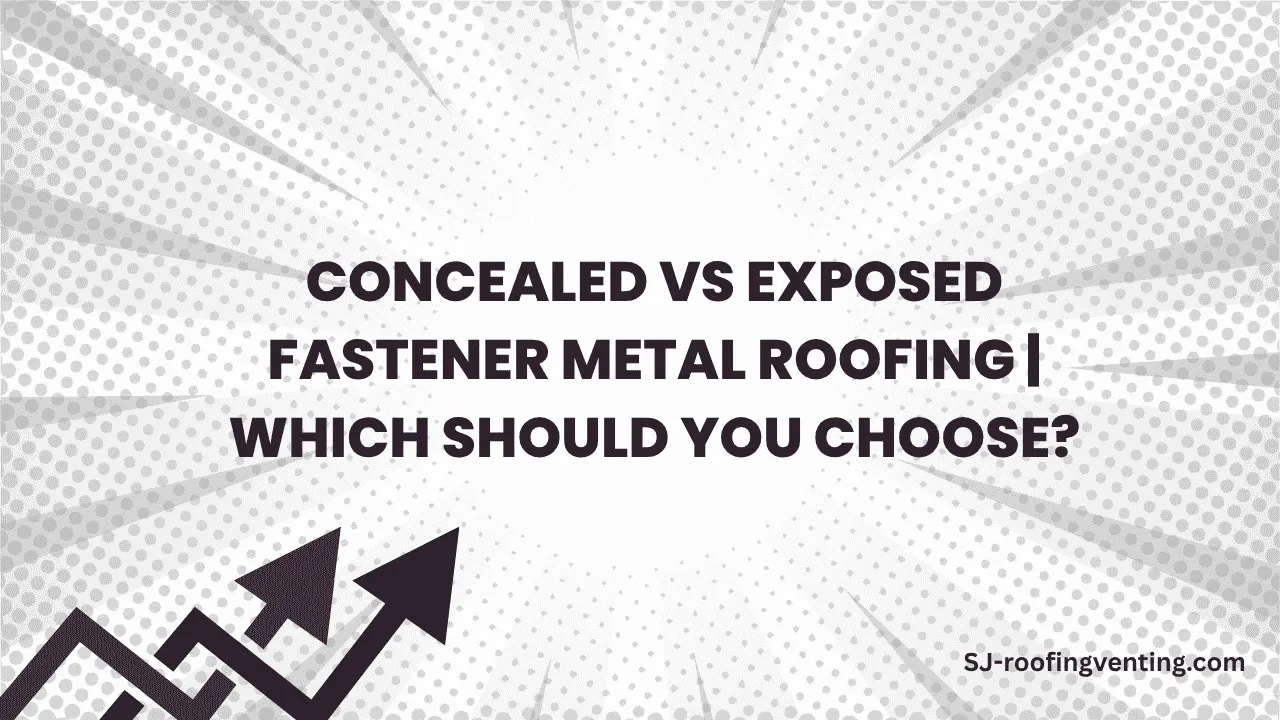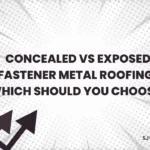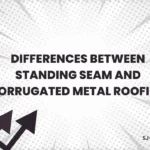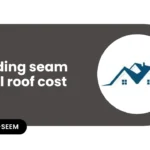Okay, when planning to install a metal roof on your home, one of the most important decisions you will make is choosing between concealed and exposed fastener systems for your roof. This choice can impact everything from cost, maintenance, aesthetics, and more. The long-term performance, durability, and overall quality are completely based on the type of roofing you choose, right?
In this guide, we’ll walk you through the differences between these two fastening systems—standing seam (concealed) and corrugated (exposed)—and help you decide which is the right fit for your home.
Understanding Fastening Systems
Okay, now we will simply understand what fastening systems are.
Fastening systems are the actual methods used to secure metal roofing panels, and they are typically done using one of two types of fastening systems.
Concealed fasteners are commonly found in standing seam panels and are hidden below the surface of the panel. They offer a smooth and uninterrupted appearance on the surface.
On the other hand, exposed fasteners are visible and go directly through the panel—either the sheet or the panel itself.
This structural difference affects the performance, weather resistance, and visual appeal of your roof, so it’s crucial to understand how each system works before making a decision.
Weather Tightness and Protection
Okay, when it comes to weather tightness, protection, and keeping water out, standing seam panels have more advantages and are better in all ways. Since the fasteners are hidden and don’t penetrate the panel surface, there are fewer chances and lower risk of leaks.Also, the panels are designed to move slightly as temperatures change, and this helps reduce stress on the fasteners and prevents gaps that can lead to moisture problems.
In contrast, exposed fastener panels rely on hundreds or even thousands of screws driven directly through the metal into the roof deck. Over time, some of these screws may become loose due to thermal expansion and contraction, potentially creating leak points. To help minimize this risk, it’s essential to use high-quality synthetic underlayment, especially in wet climates.
For homeowners in areas with harsh weather conditions, standing seam offers a more secure and longer-lasting barrier against the elements.
Ease of Installation
Okay, installation is another major factor where these two systems differ from each other.
Exposed fastener panels are easier and quicker to install. They typically come in wider sections, such as 36 inches, which means fewer panels are needed to cover the same surface area.
They are also straightforward and simple, and thus allow for a faster and more DIY-friendly installation.
They’re really easy to install.
Standing seam panels, by comparison, are narrower—usually between 12 to 18 inches wide—and involve a more complex trim system. Installation requires more precision, more time, and usually the expertise of a professional roofer. If you’re a DIY enthusiast, exposed fastener systems are likely the better choice due to their simplicity.
Comparing Costs
One of the biggest deciding factors for many homeowners is cost. Standing seam roofing systems are generally more expensive, with installation costs ranging from $8 to $14 per square foot. The higher cost is due to several factors: longer installation time, more trim, thicker metal gauges, and premium paint finishes.
Corrugated panels with exposed fasteners are much more budget-friendly, typically costing between $5 and $8 per square foot installed. Because they’re easier to install and require fewer materials, they present a more economical option, especially for smaller projects or those on a tight budget.
Maintenance Requirements
Maintenance is an area where standing seam panels clearly shine. Once installed, they require very little upkeep—just routine cleaning and occasional inspections to remove debris or check for any potential issues.
Exposed fastener panels, while still relatively low maintenance, do need more regular inspections. The screws must be checked periodically to ensure they haven’t loosened or backed out. Over time, some screws may need to be replaced or retightened to maintain the roof’s weather resistance.
For homeowners seeking a “set it and forget it” roofing solution, standing seam offers peace of mind and less long-term hassle.
Roof Slope Considerations
The slope of your roof can also influence which fastening system is appropriate. For roofs with a slope of 3:12 or greater, both panel types are generally suitable. However, for low-slope roofs—those between 1:12 and 3:12—standing seam panels are the preferred choice.
This is because standing seam systems can be mechanically seamed, creating a double-locked connection that enhances weather tightness. This feature is especially beneficial for flat or low-slope roofs, where water tends to pool and requires superior sealing.
Structural Strength and Framing
The structure of your building plays a role in panel selection as well. On residential homes with plywood decking, both panel types perform well. However, if your project involves open framing—like a metal carport, shed, or canopy—then corrugated panels are better suited due to their superior spanning ability.
Corrugated metal panels can cover longer distances between supports without sagging, making them ideal for projects without continuous solid decking.
Aesthetics and Design Appeal
Visual appeal is another area where standing seam panels stand out. These panels offer a sleek, modern look that’s often preferred by homeowners seeking a high-end appearance. They also come in a wider variety of colors and finishes, allowing you to customize your roof to match your home’s exterior perfectly.
Corrugated panels tend to have a more industrial or traditional appearance. While they can still look great in the right context, they generally lack the refined finish that standing seam offers.
It’s also worth noting that standing seam panels may experience “oil canning,” a visible waviness in the metal. While this doesn’t affect performance, it’s something to consider if aesthetics are your top priority.
Solar Panels and Snow Retention
If you’re planning to install solar panels or snow retention systems on your roof, standing seam panels offer a clear advantage. Solar panels can be attached using clamps that fasten directly to the seams—no need to drill holes into the roofing material. The same is true for snow guards, which can be clamped onto the seams without penetrating the panel surface.
In contrast, corrugated panels require holes to be drilled for mounting, which introduces additional risk for leaks. While it’s still possible to install solar or snow retention systems on these roofs, standing seam provides a cleaner and more weather-tight solution.
When to Choose Each System
An exposed fastener metal roof is the right choice if you’re looking for an affordable, DIY-friendly solution for a shed, garage, small home, or outdoor structure. It’s also the better option for open-framed applications where spanning ability is essential.
On the other hand, a standing seam roof is ideal for homeowners who want the most durable, long-lasting, and visually appealing option. It’s perfect for low-slope roofs, homes in extreme weather zones, and anyone planning to install solar panels or snow guards.
Final Thoughts
Both concealed and exposed fastener systems have their place in the world of metal roofing. Choosing between them depends on your budget, climate, roof structure, and design preferences. Standing seam offers top-tier performance and aesthetics with a higher upfront cost, while corrugated panels provide a reliable, cost-effective alternative that’s easier to install.
Whatever your choice, make sure to consult with a qualified roofing professional and purchase quality materials from a trusted supplier. Companies like Western States Metal Roofing offer factory-direct pricing and a wide variety of panels to suit your needs. For more details, you can visit their website or download their free metal roofing guide linked in the description.




